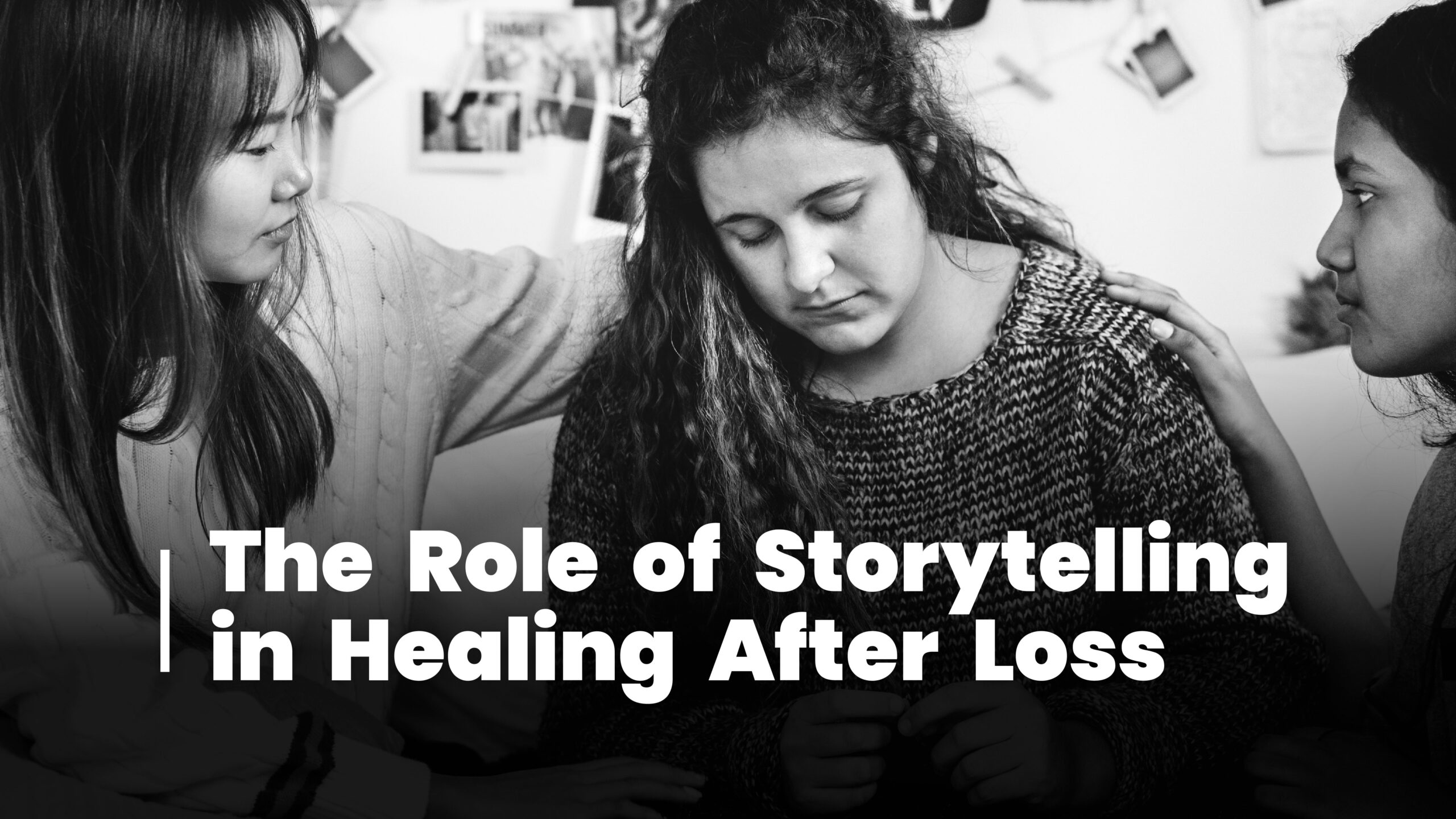
Grief is one of the most profound human experiences, shaping our emotions, memories, and sense of identity. It can feel overwhelming, isolating, and even impossible to navigate at times. Yet, throughout history, storytelling has been a powerful tool for healing after loss.
When we tell stories—whether by speaking, writing, or creating art—we give structure to our emotions, honor the memories of those we’ve lost, and find a sense of meaning in the pain. Storytelling allows us to process grief in a way that is deeply personal yet universally understood. It connects us to others, validates our emotions, and helps us make sense of a world that has changed forever.
Why Storytelling Matters in Grief
Loss creates a divide between what was and what is. The person we loved is no longer physically present, but their story continues through our memories and the ways we keep their legacy alive.
Storytelling provides a way to bridge that gap, allowing us to hold onto cherished moments while also moving forward in a way that feels meaningful. Whether through sharing a personal memory, writing in a journal, or engaging in creative expression, storytelling gives grief a voice and helps us process emotions that may otherwise feel impossible to express.
Scientific studies have shown that storytelling can help individuals process trauma, reduce anxiety, and foster resilience. It helps make sense of grief by transforming it into a narrative—one that acknowledges the loss while also honoring the love that remains.
The Therapeutic Benefits of Storytelling
Storytelling isn’t just a tradition—it’s a form of healing. Research has found that sharing personal narratives can:
- Reduce symptoms of depression, anxiety, and post-traumatic stress disorder (PTSD)
- Improve self-esteem and feelings of self-worth
- Increase resilience and coping skills
- Promote post-traumatic growth by helping individuals find new meaning after loss
For many, storytelling becomes a way to regain control over their narrative. Instead of grief feeling like an unpredictable force, storytelling provides structure and understanding. It turns painful memories into something tangible—something that can be held, shared, and cherished.
Ways to Use Storytelling for Healing
There is no right or wrong way to tell a story. Each person’s grief is unique, and so is the way they express it. Here are a few powerful methods for using storytelling as a tool for healing:
Journaling
Writing in a journal is one of the most accessible ways to process grief. Putting thoughts into words can help clarify emotions, release pent-up feelings, and create a space for reflection. Journaling doesn’t have to follow any structure—it can be as simple as writing a letter to a loved one, listing memories, or reflecting on the emotions of the day.
One unique journaling method is dominant non-dominant hand writing (also called left-right handed journaling). This technique involves writing a question with your dominant hand and answering it with your non-dominant hand, which allows for a more intuitive, emotional response. Many find this method helpful for uncovering feelings that may be difficult to access through traditional writing.
Creative Writing
For those who struggle to talk about their grief directly, creative writing can be an alternative form of expression. Whether through poetry, fiction, or songwriting, creative storytelling allows individuals to explore emotions in a different way.
Some find comfort in writing fictional characters that experience similar losses, using storytelling as a way to process their own pain through a new lens. Others may use poetry to capture the depth of their emotions in a more symbolic or abstract way.
Narrative Therapy
Narrative therapy is a guided approach in which individuals work with a therapist to explore their personal stories. This method helps reframe grief, allowing people to focus on the love, connection, and resilience that exist alongside the pain.
Through narrative therapy, individuals can challenge negative beliefs, reshape their understanding of loss, and find new ways to carry their loved one’s memory forward. It encourages them to see themselves not just as someone who has lost, but as someone who continues to grow and heal.
Alternative Approaches for Those Without a Clear Narrative
Not everyone has a coherent or complete memory of their grief experience. For some, trauma makes it difficult to recall details or put feelings into words. In these cases, alternative forms of storytelling—such as art, music, and movement—can provide powerful pathways to healing.
- Art therapy allows individuals to express emotions visually, whether through painting, drawing, or sculpting. The act of creating can be a release for emotions that feel difficult to verbalize.
- Music therapy uses sound and rhythm to access emotions. Listening to meaningful songs, composing music, or even simply drumming along to a beat can help process grief.
- Movement-based therapies like dance or yoga provide a physical way to release emotions. Sometimes, movement speaks louder than words, allowing individuals to work through grief with their bodies rather than their voices.
Honoring Memories Through Storytelling
One of the most profound aspects of storytelling is its ability to keep memories alive. When we share stories of our loved ones—whether through spoken word, writing, or artistic expression—we ensure that their legacy continues.
There are many ways to honor a loved one’s memory through storytelling:
- Create a memory book filled with photos, letters, and written reflections
- Record video or audio interviews of family members sharing their favorite stories
- Write a letter to your loved one expressing thoughts, updates, or things left unsaid
- Start a new tradition in their honor, whether it’s lighting a candle on special days or sharing a favorite meal together as a family
These acts of remembrance not only preserve a loved one’s story but also provide comfort to those left behind. They reinforce the idea that grief is not about forgetting—it’s about carrying their memory forward in meaningful ways.
The Power of Shared Grief Stories
Grief can feel incredibly isolating, but storytelling has the power to connect people who are walking similar paths. When we hear others share their experiences of loss, we are reminded that we are not alone.
Reading or listening to others’ grief stories can be a source of comfort and validation. It helps to know that others have felt what we feel, struggled as we struggle, and found ways to heal. This sense of shared humanity can provide strength in moments of deep sorrow.
For those who are hesitant to share their own grief, hearing another person’s story can be the first step toward opening up. It shows that pain is not something to be hidden—it is something to be acknowledged, expressed, and shared.
Encouraging Storytelling in Times of Loss
Starting the storytelling process can feel daunting, especially when emotions are raw. However, even small acts of storytelling can be meaningful.
Here are a few gentle ways to begin:
- Ask open-ended questions about a loved one’s life, memories, or personality
- Set aside time for storytelling, whether through journaling, conversation, or creative projects
- Create a safe, judgment-free space for sharing emotions and reflections
- Encourage family and friends to contribute their own stories and perspectives
Storytelling doesn’t have to be a formal or structured process. It can be as simple as reminiscing over a meal, flipping through old photos, or jotting down a thought when it comes to mind. The important part is allowing space for memories to be honored and emotions to be expressed.
Closing Thoughts
Storytelling is one of the most powerful tools we have for healing after loss. It allows us to express grief, honor memories, and find meaning in the midst of pain. Every story shared is a step toward healing—both for the storyteller and for those who listen.
At Cremation Service of Western NY, we believe that every life is a story worth telling. Whether through words, art, or shared traditions, we encourage you to find ways to keep the memory of your loved ones alive. If you need guidance or support during your grief journey, we are here for you.

 Cremation Service of Western New York can provide you with answers to many commonly asked questions about cremation. Our goal is to provide detailed comprehensive information regarding cremation and the services we can provide for you.
Cremation Service of Western New York can provide you with answers to many commonly asked questions about cremation. Our goal is to provide detailed comprehensive information regarding cremation and the services we can provide for you.
Post a comment